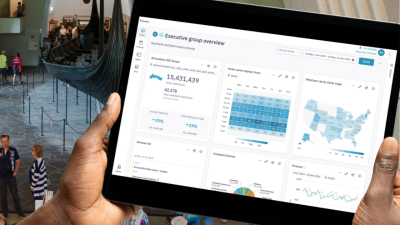
Champion museums and nurture excellence in partnership with our members and allies. This is the Alliance’s mission statement and a call to action that is driving results across the museum field. There is no Alliance without our members!
One of the areas in which we, together, are making real change is diversity, equity, accessibility, and inclusion (DEAI) in all aspects of museums’ structures and programming. And an important component of pursuing DEAI in museums is taking a critical look at how we hire, retain, and promote people.
I believe the museum field must address equity issues comprehensively and creatively—and together we can continue to challenge status-quo thinking in all aspects of equitable hiring. One of AAM’s strongest tools is to lead by example. We are leading with our own DEAI initiatives, and we are seeing results.
We have written and presented about our journey to reduce bias in AAM’s own recruitment process, which I’m proud to say has also been covered by the Society for Human Resource Management (SHRM) as a nonprofit best practice. AAM now posts salary ranges for most of our open positions and urges applicants to submit resumes without personally identifiable, potentially biasing, information. The Alliance partnered with GapJumpers to connect museums with resources for tailoring challenge-based hiring experiences to their own staffing needs. And we have worked to advance knowledge and understanding on a range of related topics on this site, in Museum magazine, at the AAM Annual Meeting & MuseumExpo, and in other convenings and professional development events. Many of you have told me these models and conversations have informed and altered your own hiring practices to be more equitable.
Skip over related stories to continue reading articleVoices across our field have engaged on these issues with a lot of excitement and opinions, including suggestions that AAM mandate that all job postings on our JobHQ website list salary ranges, among other ideas. I appreciate that these appeals are made with passion and commitment to equity for museum workers and to excellence for our profession.
I share that passion and commitment, and, as a hiring manager for 20+ years, I agree that including salary ranges in job postings (or discussions of salary expectations early in the process) can help expedite finding a good match—for both hiring organizations and job seekers. It may also help advance the diversity of candidates and pay equity when combined with many other changes in traditional hiring practices (e.g., reviewing and updating education/experience requirements, implementing blind hiring techniques).
However, it is not our practice to institute strict, national, one-size-fits-all requirements. The beauty and strength of our Alliance is the range of people and museums we represent. Even the core standards for museums are not prescriptive—they are broad, adaptable, outcome-oriented statements fulfilled by each museum in different ways based on its discipline, type, budget, governance structure, and other unique circumstances.
After thorough consideration, we continue to believe that AAM should not mandate the specific actions a museum takes to demonstrate its commitment to providing equitable opportunities for all. So at this time, we do not plan to implement a requirement to list pay, which is often governed by myriad federal, state, and local labor laws; umbrella-institution policies; labor union contracts; and more.
Instead, we will continue to serve as a platform to facilitate the exchange of opinions, approaches, and expertise on museum operations and practices; provide resources to help museum professionals make informed decisions based on their unique circumstances; model what we believe to be best practices; and evaluate those best practices with broad field-wide consensus for inclusion in our standards and professional practices.
To further the discussion, we invite HR directors and hiring managers from museums who are trying various techniques, including posting salary ranges, to share their experiences, learnings, and results with the field. We have also placed a prominent message on the JobHQ page where hiring companies prepare their listings, strongly recommending that they include a salary or salary range, and linking to supporting information about why it’s important to do so. You can find additional resources, insights, and guidance on our website, including:
- Examples from the field on the human resources section of the Alliance blog
- Free resources related to inclusive hiring practices and additional HR resources in the AAM Resource Library, accessible to AAM members
- Guidance for job seekers on our career page, including on salary negotiation
How does your museum work to advance equity in the museum field? Help us identify success stories to share by commenting below.









Since most other national museum organizations (ACM, AASLH, SMA, etc.) as well as a large number of regional, state, and local museum organizations, currently find no problem in requiring salary ranges be included in job postings, AAM’s continued outlier status through this statement gives cover to “bad actors” continuing to exploit museum workers and take advantage of rationalizations like the one AAM has just provided.
It can’t help but seem that AAM’s concern for potential lost revenue from JobHQ ads drives this stance more than concern for museum job applicants.
Mr. Orselli makes a good point.
AAM members should note Pres. & CEO Lott’s first statement about the AAM mission says “champion museums” & continues to mention nurturing excellence through cooperation with “our members” & collaborators. I believe AMM individual members need to begin to question whether the AAM also champions the interests of its members who happen to be “museum workers” as well as the interests of museums as institutions. May I suggest that the interests of institutions as employers do not always match the best interests of their employees.
I always like to remind interested parties that the AAM Code of Ethics for Museums (2000) states in the same sentence that the governing authority of museum institutions commit themselves to protect and enhance not only the museum’s collections, programmes, physical, and financial resources, but their “human resources” as well.
Sadly, as the AAM Constitution presently stands, AAM members are not permitted to resolve to direct the AAM on any substantive matter (other than to amend the Constitution) when members might wish to have the AAM investigate and/or take action on whether member institutions actually are protecting the best interests of their human resources.
Food for thought–& possible amendment of the AAM Constitution.